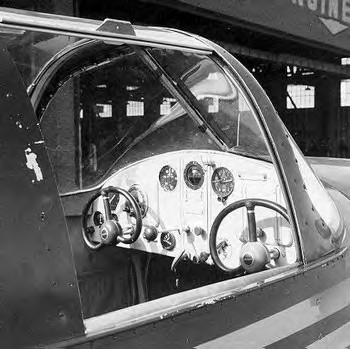An aircraft “incapable of
spinning” sold in the men's department of Macy's
department store? That is the claim to fame of the
Ercoupe—a twin-tail airplane designed by Fred Weick
and named after its manufacturer, the Engineering
and Research Corporation (ERCO), located in
Riverdale, Maryland.
Weick, assistant chief of the
aeronautics division of the National Committee on
Aeronautics (NACA), predecessor to the National
Aeronautics and Space Administration, designed and
assembled an experimental airplane in 1934 with a
group of his colleagues. Responding to a Bureau of
Air Commerce-sponsored design competition to build
an easy-to-fly, safe airplane, Weick and his friends
worked on the project in their spare time and paid
for it themselves.
The test aircraft built by Weick,
known as the W-1, featured tricycle landing gear, a
high parasol wing, and a pusher propeller
configuration (with the propeller located behind the
main supporting surfaces). The single engine was
used for economy of operation and the tricycle gear
was intended to prevent "nose over” landing
accidents where the airplane would flip over on its
nose.
Weick left NACA in 1936 and
joined ERCO's fledgling aircraft team as chief
designer, primarily to continue improving his
airplane design. Focusing his efforts on a number of
design issues, primarily simplicity and safety,
Weick strove to create a reasonably priced aircraft
that would not stall or spin. Retaining the tricycle
gear (for ease of manoeuvring on the ground), Weick
switched to a low-wing monoplane configuration in
his improved model, powered by a tractor engine (the
propeller located forward of the main supporting
surfaces).

The refined W-1A (originally
known as the ERCO 310) made its first flight in
October 1937 and was soon renamed the “Ercoupe.” The
twin-tail Ercoupe became an instant sensation
because of its easy-to-fly design and unique design
features, including a bubble canopy for great
visibility. Lacking rudder pedals, the Ercoupe was
flown entirely using only a control wheel: a
two-control system linked the rudder and aileron
systems, which controlled yaw and roll, with the
steerable nose wheel. This wheel controlled the
pitch and the steering of the airplane, both on the
ground and in the air, simplifying control and
coordinated turning and eliminating the need for
rudder pedals. A completely new category of pilot's
license had to be created for Ercoupe pilots who had
never used a rudder pedal. The Ercoupe was the first
plane to incorporate much of the original research
that Weick had performed while at the NACA,
including the wholly cowled engine.
Targeted at the non-professional
pilot, the Ercoupe was also designed to be
spin-proof with no dangerous stall characteristics.
A placard, which was the first for any airplane, was
allowed to be placed proudly on the instrument panel
reading: "This aircraft characteristically incapable
of spinning." An elevator that could move upward and
downward only a limited amount—13 degrees—plus
automatic yaw correction, enabled the airplane to
actually fly itself out of a spin. Inexpensive to
operate and maintain, the Ercoupe was able to fly
into and out of small airfields, and its nose-wheel
steering made taxiing almost like driving an
automobile.
The two-seat ERCO Ercoupe 415
went on sale in 1940 but only 112 were delivered
before World War II intervened, halting all civil
aircraft production. By mid-1941, aluminium supplies
were being diverted to war-related production, so
ERCO decided to manufacture Ercoupes for military
use by using wood as the principal building
material. The substitution of wood resulted in a
heavier Ercoupe, but the aircraft flew much more
quietly because the wood absorbed vibrations from
the engine and air flow. Ercoupes were flown during
the war by the Civilian Pilot Training Program for
flight instruction, and the Civil Air Patrol used
them to patrol for German submarines.
The Ercoupe also was the first
U.S airplane to take off assisted by a rocket. In
August 1941, an Ercoupe, powered by a 65-horsepower
(48-kilowatt) Continental engine, was converted into
a Jet Assisted Take-Off (JATO) airplane when six
pressed-powder rockets were attached to the
Ercoupe's wings at March Field, California. Lt.
Homer A. Boushey of the U.S. Army Air Forces ignited
a blend of perchlorate, asphalt, and special oils
with an instrument panel switch and the JATO Ercoupe
took off with a brilliant flash and billowing smoke,
cutting the aircraft's normal takeoff time and
distance in half.
Production resumed after the war
and initial sales were strong; ERCO manufactured
more than 4,000 aircraft in 1946 alone. In February
of that year, Fred Weick was recognized for his work
on the Ercoupe, receiving the Fawcett Aviation Award
for the greatest contribution to the scientific
advancement of private flying.
At its peak, ERCO was turning out
34 Ercoupes per day, operating three shifts per day.
The airplane was aggressively marketed through
non-conventional outlets such as the men's
department of the Macy's department store chain.
Unfortunately, however, private aircraft sales
slumped after the war and the bottom dropped out of
the civil aircraft market in late 1946, bursting the
bubble held by many aircraft manufacturers, who had
expected that post-war prosperity plus a huge number
of newly trained pilots would translate into a boom
market for civil aircraft sales.
ERCO sold its remaining Ercoupe
inventory to Saunders Aircraft Company in 1947,
which continued to sell the airplanes until 1950.
Several other companies continued to build Ercoupes
and variations (some renamed as “Aircoupes”) for
another 20 years until production ended in 1970.
Fred Weick went on to become a
pioneer in agricultural aircraft design, leading
Piper Aircraft's efforts in that field and later
helped to design the popular Piper Comanche. These
notable endeavours notwithstanding, Weick will
always be remembered as the “Father of the Ercoupe”—the
revolutionary rudderless airplane.
performance and specifications
